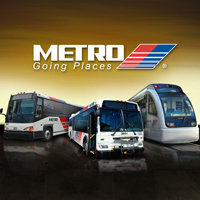I commend you to read Christopher Andrews’ report of a recent meeting between Metro Board Chair Carrin Patman and group of local transportation-interested bloggers. I quote here from his recap of what Patman has in mind for Metro while she is Chair:
1. A Regional Transportation / Transit Plan
The last plan dates back to 2003, and much has changed in Houston since then. The plan gave us the existing rail lines, except for the University Line, which has now lost any form of federal funding that was once available. Patman said that it is time to start a new plan, likely asking for bonding authority to pay for future improvements, possibly specifying routes or modes of transit. As Houston continues to grow, it’s inevitable that there will need to be increased opportunities for transit, not simply adding highway lanes.Patman said that the agency needs to continue to look at adopting every mode of transit, whether rail or bus rapid transit. She also noted the possibility of a Hobby Airport rail extension as part of the plan, and the need to establish an east-west connection into Houston’s Galleria / Uptown District area. It is arguably Houston’s fastest growing center, but still does not effectively tie into METRO’s Park and Ride system, although this problem is slated to be relieved with the Uptown BRT line. (It’s worth noting that the Galleria is linked to Downtown Houston through the 82 bus route, which has been the backbone of the bus system for a long time, and has routes with peak 6 minute frequency, and off-peak frequency of 10 minutes.)
2. New Bus Network Improvements
In her most recent Houston Matters interview Patman noted that change sometimes brings unintended consequences, which METRO has experienced in select areas with respect to the New Bus Network. Selected bus routes were changed, especially in low ridership areas, leaving some riders without bus options. this is especially difficult because many of those left without bus options rely on the bus for transit.Patman assured that the agency will not leave out those that are without bus service. I think that’s a tough promise to keep as many parts of METRO’s service area may not justify a route that transports a small number of riders. As seen with the New Bus Network, there is a balance for the agency in providing coverage compared to frequency. Without adding additional resources, likely at a cost, greater frequency (which is probably the more important of the two to many riders) cannot happen.
METRO has been using their Community Connector service in Acres Homes, with fair ridership according to METRO staff. The Community Connector acts as an “on-demand” service within a particular zone to provide connectivity between major destinations and the Acres Homes Transit Center. This program was compared to Helsinki, Finland’s now-defunct Kutsuplus program, which acted somewhat as an Uber Pool-type program. Aimed at decreasing the need for private cars and providing a connection between many of Helsinki’s north-south oriented bus lines, the program was initially successful, then came to an abrupt end at the end of 2015. The program needed a larger scale in order to be more profitable, and the cost of doing so would have been heavily supplemented by taxpayers. It’s important to remember that this is a method for supplementing trips in areas that may not warrant as many frequent bus routes.
3. Marketing and Ridership Experience
Patman’s final major goal was the continuation of improving the ridership experience on METRO’s bus and rail lines, as well as marketing the system to new users.
Andrews notes my post on how Metro might market itself, then goes on to make his own suggestions. There are themes from my other posts as well. Patman specifically said that she reads what those of us who were there have to say about Metro and what it is (and should be) doing. My reaction after that meeting is that they’ve already got this figured out, and are doing or at least studying plenty of the things all of us had in mind. It’s encouraging to see, and again I urge you to read Andrews’ report as well as the one that was posted on the Metro blog.
I still have a post to write about where things are and where they may go with rail, but I’m still thinking about it. In the meantime, there were some more tweaks applied to the new bus network.
The transit agency makes service adjustments three times a year. Those changes are made in January, at the end of the school year, and at the start of classes in the fall. The latest changes affect over thirty Metro routes and that includes both local buses and park and rides. They went into effect last weekend.
Metro’s Jerome Gray says one thing they’re trying to do is ease overcrowding on some of the more popular routes.
“We’ve added some trips earlier in the morning to accommodate people asking for that,” Gray says.
Changes also affect the park-and-ride buses. Gray says ridership usually dips toward the end of the school year and they also thought they’d have fewer riders because of oil and gas layoffs. But it turns out that wasn’t the case.
“Interestingly enough on several of those park and ride routes we’ve actually seen an uptick in the ridership,” says Gray. “I think a number of people are just opting to not drive their car all the way into work. They’re opting to park it and get on the bus.”
You can see all the changes here. As the KUHF story notes, there will be more to come, with a new Manchester/Lawndale route to the Magnolia Transit Center set to debut in July. I promise to have my rail post done before then.

